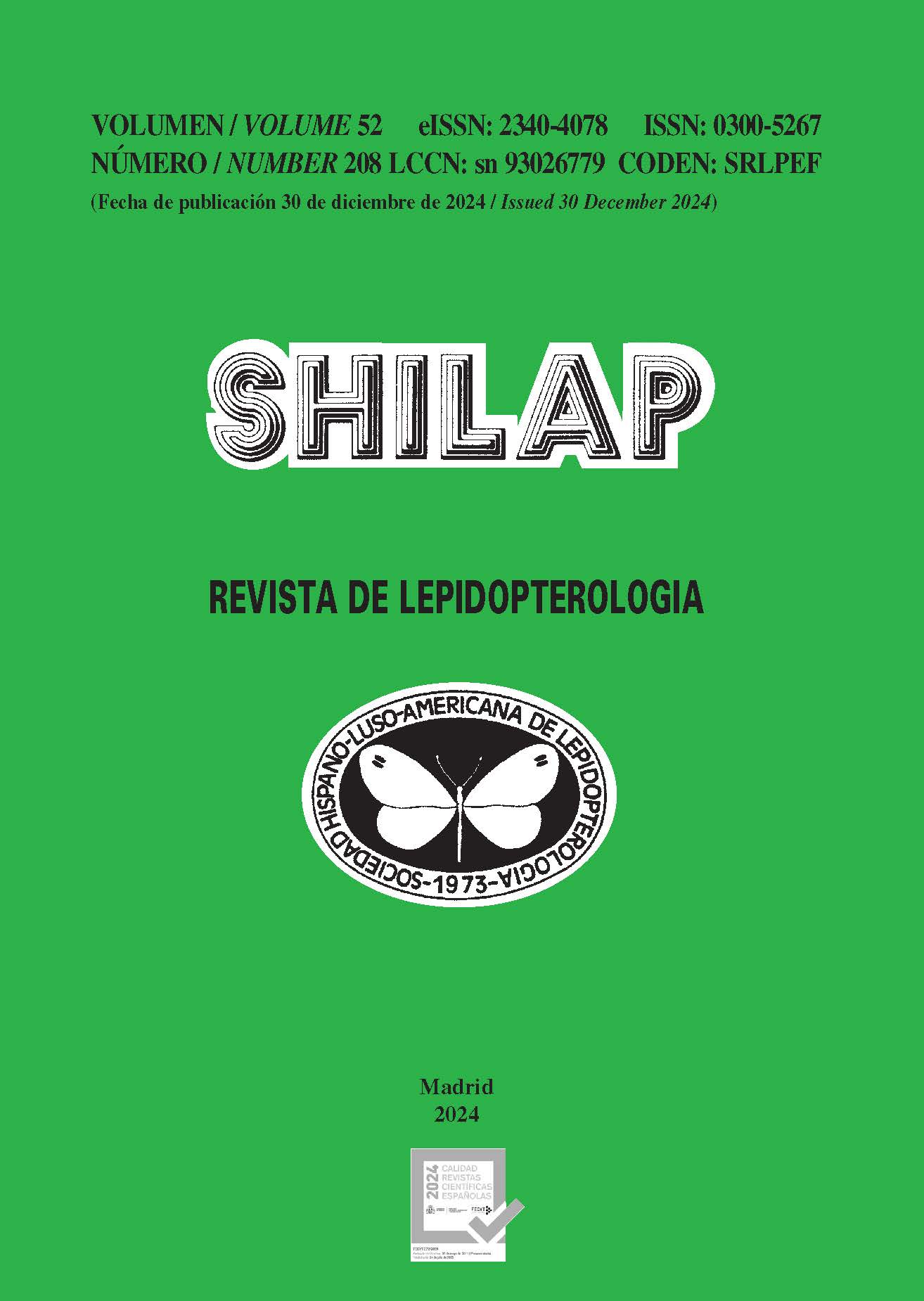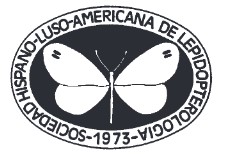Imma phuocbuu Buchsbaum, Chi & Chen, sp. nov. aus Süd Vietnam (Lepidoptera: Immidae)
DOI:
https://doi.org/10.57065/shilap.1016Schlagworte:
Lepidoptera, Immidae, Imma phuocbuu, Verbreitung, Biotop, VietnamAbstract
Während einer faunistischen Untersuchung von Lepidoptera im Jahr 2023 wurde Imma phuocbuu Buchsbaum, Chi & Chen, sp. nov. entdeckt und stellt den ersten Nachweis der Gattung in Vietnam dar. Ein einzelnes männliches Exemplar wurde in einem Übergangsbiotop zwischen Mangroven und halbtrockenen Tieflandwäldern in Küstennähe gesammelt. Die neue Art unterscheidet sich von Imma transversella (Snellen, 1878), I. semicitra Meyrick, 1937 und I. semiclara Meyrick, 1929 durch Unterschiede in der Flügelzeichnung und der Morphologie der Genitalien.
Downloads
Globale Statistiken ℹ️
|
708
Aufrufe
|
150
Downloads
|
|
858
Gesamt
|
|
Literaturhinweise
Averyanov, L. V., Loc, PO. K., Hiep, N. T., & Harder, D. K. (2003). Phytogeographyc review of Vietnam and adjected areas of Eastern Indochina. Komarovia, 3, 1-83.
Brooks, T (2010). Conservation planning and priorities, Chapter 11. In N. S. Sodhi & P. R. Ehrlich (eds.). Conservation Biology for All, Oxford, 2010, 199-219. https://doi.org/10.1093/acprof:oso/9780199554232.003.0012 DOI: https://doi.org/10.1093/acprof:oso/9780199554232.003.0012
Brooks, T. M., Mittermeier, R. A., Mittermeier, C. G., da Fonseca, G. A. B., Rylands, A. B., Konstant, W. R., Flick, P., Pilgrim, J., Oldfield, S., Magin, G., & Hilton-Taylors, C. (2002). Habitat Loss and Extinction in the Hotspots of Biodiversity. Conservation Biology, 16(4), 909-923. https://doi.org/10.1046/j.1523-1739.2002.00530.x DOI: https://doi.org/10.1046/j.1523-1739.2002.00530.x
Buchsbaum, U., Grehan, J. R., Chen, M.-Y., Chi, N. M., Pham, D. L., Khai, T. Q., Jones, L. D., & Ignatev, N. (2022). New species of Endoclita C. and R. Felder, 1874 and first record of. E. salvazi from Vietnam (Insecta: Lepidoptera: Hepialidae). Vernate, 41, 267-286.
Buchsbaum, U. (2019). A new species of the genus Ceneressa Obraztsov, 1957 from northern Thailand (Lepidoptera, Erebidae, Arctiinae, Syntomini). Nachrichten des entomologischen Vereins Apollo, N. F., 40(1), 62-64.
Buchsbaum, U., Brüggemeier, F., & Chen, M.-Y. (2014). A new species of the genus Callidrepana Felder, 1861 from Laos (Lepidoptera, Drepanidae). Entomofauna, Supplement, 17, 45-53.
Callighan, C. J. (2009). The Riodinid Butterflies of Vietnam (Lepidoptera). Journal of the Lepidopterologists’ Society, 63(2), 61-82.
Cerny, K., & Pinratana, B. A. (2007). Arctiidae. Moths of Thailand (Vol. 6). Brothers of Saint Gabriel.
Clarke, J. F. G. (1986). Pyralidae and Microlepidoptera of the Marquesas Archipelago. Smithsonian Contributions to Zoology, Washington, 416. https://doi.org/10.5479/si.00810282.416 DOI: https://doi.org/10.5479/si.00810282.416
De Lattin, G. (1967). Grundriss der Zoogeographie. VEB Gustav Fischen Verlag Jena.
Diakonoff, A. (1986). Glyphipterygidae auctorum sensu lato (Glyphipterygidae sensu Meyrick, 1913); Tortricidae: Hilarographini, Choreutidae, Brachodidae (partim), Immidae and Glyphipterygidae. Microlepidoptera Palaearctica (Vol. 7). G. Braun.
Dugdale, J.S., Kristensen, N.P., Robinson, G.S. & Scoble. M.J. (1999) The smaller Microlepidoptera-Grade Superfamiles. In: Kristensen, N.P. (ed.), Handbook of Zoology, volume 4, Arthropoda: Insecta, part 35. Lepidoptera, moths and butterflies, volume 1: Evolution, Systematics, and Biogeography. Walter de Gruyter. DOI: https://doi.org/10.1515/9783110804744.217
Fa, J. E., & Funk, S. M. (2007). Global endemicity centres for terrestrial vertrebrates: an ecoregions approach. Endangered Species Research, 3, 31-52. https://doi.org/10.3354/esr003031 DOI: https://doi.org/10.3354/esr003031
Heppner, J. B. (1977). The status of the Glyphipterigidae and a reassessment of relationships in Yponomeutoid families and ditrysian superfamilies. Journal of the Lepidopterists’ Society, 31, 124-134.
Heppner, J. B. (1982a). Review of the family Immidae, with a world checklist (Lepidoptera: Immoidea). Entomography, 1, 257-279.
Heppner, J. B. (1982b). Synopsis of the Glyphipterigidae (Lepidoptera: Copromorphoidea) of the world. Proceedings of the Entomological Society of Washington, 84, 38-66.
Heppner, J. B. (1991). Faunal Regions and the Diversity of Lepidoptera. Tropical Lepidoptera, 2(Suppl. 1), 1-85.
Holloway, J. D., Kibby, G., & D. Peggie (2001). The Families of Malesian moths and butterflies. Brill. https://doi.org/10.1163/9789004475595 DOI: https://doi.org/10.1163/9789004475595
Kier, G., Kraft, H., Lee, T. M., Jetz, W., Ibisch, P. L., Nowicki, C., Mutke, J., & Barthlott, W. (2009). A global assessment of endemism and species richness across island and mainland regions. PNAS, 106(23), 9322-9327. https://doi.org/10.1073/pnas.0810306106 PMid:19470638 PMCid:PMC2685248 DOI: https://doi.org/10.1073/pnas.0810306106
Küppers, P. V., & Buchsbaum, U. (2015). Phacusa janikornae sp. n. from South Thailand (Lepidoptera, Zygaenidae, Procridinae) with description of the biology. Nachrichten des entomologischen Vereins Apollo, N. F., 36(2/3), 148-152.
Manh, V. Q. (2015). Zoogeographical division of Vietnam based on the Oribatid Mite (Acari: Oribatida) Fauna. Tap Chi Sinh Hoc, 37(3), 353-361. https://doi.org/10.15625/0866-7160/v37n3.7592 DOI: https://doi.org/10.15625/0866-7160/v37n3.7592
Marchese, C. (2015). Biodiversity hotspots: A shortcut for more complicated concept. Global Ecology and Conservation, 3, 297-309. https://doi.org/10.1016/j.gecco.2014.12.008 DOI: https://doi.org/10.1016/j.gecco.2014.12.008
Ministery of Natural Resources and Environment (MONRE) (2020). Vietnam National Biodiversity Strategy to 2020, Vision to 2030. Hanoi.
Mittermeier, R. A., Turner, W. R., Larsen, F. W., Brooks, T. M., & Gascon, C. (2011). Global Biodiversity Conservation: the Critical Role of Hotspots, Chapter 1. In F. E. Zachos & J. C. Habel (eds.). Biodiversity Hotspots. https://doi.org/10.1007/978-3-642-20992-5_1 DOI: https://doi.org/10.1007/978-3-642-20992-5_1
Mittermeier, R. A., Myers, N., Thomsen, J. B., da Fonseca, G. A. B., & Olivieri, S. (1998). Biodiversity Hotspots and Major Tropical Wilderness Areas: Approaches to Setting Conservation Priorities. Conservation Biology, 12(3), 516-520. https://doi.org/10.1046/j.1523-1739.1998.012003516.x DOI: https://doi.org/10.1046/j.1523-1739.1998.012003516.x
Myers, N., Mittermeier, R. A., Mittermeier, C. G., da Fonseca, G. A. B., & Kent, J. (2000): Biodiversity hotspots for conservation priorities. Nature, 403, 853-858. https://doi.org/10.1038/35002501 PMid:10706275 DOI: https://doi.org/10.1038/35002501
Olson, D. M., & Dinerstein, E., (2002). The Global 200: Priority Ecoregions for Global Conservation. Annals of the Missouri Botanical Garden, 89(2), 199-224. https://doi.org/10.2307/3298564 DOI: https://doi.org/10.2307/3298564
Phuong, V. T., & Lin, T. M. (2011). Final report on Forest Ecological Stratification in Vietnam. UN-REDD Programme Vietnam.
Robinson, G. S. (1976). The preparation of slides of Lepidoptera genitalia with special reference to the Microlepidoptera. Entomologist’s Gazette, 27, 127-132.
Robinson, G. S., Tuck, K. R., & Shaffer, M. (1994). A Field Guide to the smaller moths of South-East Asia. Malaysian Nature Society.
Schintlemeister, A. (1997a). Moths of Vietnam with special reference to Mt. Fan-si-pan. Introduction and collection localities. Entomofauna, Supplement, 9(1), 1-12.
Schintlemeister, A. (1997b). Moths of Vietnam with special reference to Mt. Fan-si-pan. Family Notodontidae. Entomofauna, Supplement, 9(4), 33-248.
Schintlmeister, A. (2001). Zoogeographie vietnamesischer Heterocera unter besonderer Berücksichtigung der Zahnspinner (Lepidoptera: Notodontidae). Phyllodrom-Journal. Abhandlungen und Berichte aus der Regenwaldforschung. Tagungsberichte / Phyllodrom-Journal. Abhandlungen und Berichte aus der Regenwaldforschung. Tagungsberichte (Vol. 1, pp. 89-90).
Schintlmeister, A. (2003). The zoogeography of Taiwans’s Notodontidae (Lepidoptera). Journal of the Zoological Society Wallacea, 1, 15-26.
Schintlmeister, A., & Pinratana, B. A. (2007). Moths of Thailand. Notodontidae (Vol. 5). Brothers of Saint Gabriel. https://doi.org/10.1163/9789004260993 DOI: https://doi.org/10.1163/9789004260993
Sechrest, W., Brooks, T. M., de Fonseca, G. A. B., Konstant, W. R., Mittermeier, R. A., Purvis, A., Rylands, A. B., & Gittleman, J. L. (2002). Hotsspots and the conservation of evolutionary history. PNAS, 99(4), 2067-2071. https://doi.org/10.1073/pnas.251680798 PMid:11854502 PMCid:PMC122320 DOI: https://doi.org/10.1073/pnas.251680798
Smith, J. R., Hendershot, J. N., Nova, N., & Daily G. C. (2020). The biogeography of ecoregions: Descriptive power across the regions and taxa. Journal of Biogeography, 47(7), 1413-1426. https://doi.org/10.1111/jbi.13871 DOI: https://doi.org/10.1111/jbi.13871
Sodhi, N. S., Koh, L.-P., Brook, B. W., & Ng, P. K. L. (2004). Southeast Asian biodiversity: an impending disaster. TRENDS in Ecology and Evolution, 19(12), 654-660. https://doi.org/10.1016/j.tree.2004.09.006 PMid:16701328 DOI: https://doi.org/10.1016/j.tree.2004.09.006
Turner, H., Hovenkamp, P., & van Welzen, P. C. (2001). Biogeography of Southeast Asia and the West Pacific. Journal of Biogeography, 28, 217-230. https://doi.org/10.1046/j.1365-2699.2001.00526.x DOI: https://doi.org/10.1046/j.1365-2699.2001.00526.x
Wondroff, D. S. (2010). Biogeography and conservation in Southeast Asia: shows 2.7 million years of repeated environmental fluctuations affect today’s patterns and the future of the remaining refugial-phase biodiversity. Biodiversity Conservation, 19(4), 919-941. https://doi.org/10.1007/s10531-010-9783-3 DOI: https://doi.org/10.1007/s10531-010-9783-3
Vu, L. V. & Vu, C. Q. (2011), Diversity pattern of Butterfly communities (Lepidoptera, Papilionoidea) in different habitat types in a tropical rain forest of southern Vietnam. DOI: https://doi.org/10.5402/2011/818545
Downloads
Veröffentlicht
Zitationsvorschlag
Ausgabe
Rubrik
Lizenz
Copyright (c) 2024 Ulf Buchsbaum, Mei-Yu Chen, Nguyen Minh Chi

Dieses Werk steht unter der Lizenz Creative Commons Namensnennung 4.0 International.
Der Autor behält sich seine Marken- und Patentrechte an allen in diesem Artikel enthaltenen Verfahren und Prozessen vor.
Der Autor behält sich das Recht vor, den im SHILAP Revista de lepidopterología veröffentlichten Artikel zu teilen, zu verbreiten, aufzuführen und öffentlich zu kommunizieren, mit der anfänglicher Anerkennung der Veröffentlichung im SHILAP Revista de lepidopterología.
Der Autor behält sich das Recht auf eine spätere Veröffentlichung seiner Arbeit vor, von der Verwendung des Artikels bis hin zur Veröffentlichung in einem Buch, vorausgesetzt, er weist auf die Erstveröffentlichung im SHILAP Revista de lepidopterología hin.
Jeder Einreichung für das SHILAP Revista de lepidopterología muss eine Anerkennung des Urheberrechts und eine Bestätigung der Autorenschaft beigefügt sein. Mit ihrer Annahme behalten die Autoren das Urheberrecht an ihrer Arbeit und erklären sich damit einverstanden, dass der Artikel, wenn er von SHILAP Revista de lepidopterología zur Veröffentlichung angenommen wird, für die Nutzung und Verbreitung unter einer "Creative Commons Attribution 4.0 International" (CC BY 4.0)-Lizenz lizenziert wird, die es Dritten erlaubt, den Inhalt für jeden Zweck zu teilen und zu bearbeiten, wobei das Originalwerk angemessen zu erwähnen ist.
Eine informative Version und den Rechtstext der Lizenz finden Sie hier. Der Hinweis auf die CC BY 4.0-Lizenz muss erforderlichenfalls ausdrücklich auf diese Weise erfolgen.
Ab 2022 ist der Inhalt der gedruckten und digitalen Version unter einer "Creative Commons Attibution 4.0 International" (CC BY 4.0) -Lizenz lizenziert wird, die es Dritten erlaubt, den Inhalt für jeden Zweck zu teilen und zu bearbeiten, wobei das Originalwerk angemessen zu erwähnen ist.
Frühere Inhalte der Zeitschrift wurden unter einer herkömmlichen Urheberrechtslizenz veröffentlicht; das Archiv ist jedoch frei zugänglich.
Ao utilizar o conteúdo do SHILAP Revista de lepidopterología publicado antes do ano 2022, incluindo figuras, tabelas ou qualquer outro material em formato impresso ou eletrónico pertencem aos autores dos artigos, os autores devem obter a autorização do detentor dos direitos de autor. As responsabilidades legais, financeiras e criminais a este respeito pertencem ao(s) autor(es).
In Anwendung des Prioritätsprinzips des Internationalen Kodex der Zoologischen Nomenklatur darf keine andere als die vom Herausgeber veröffentlichte Version in Repositorien, persönlichen Websites oder ähnlichem hinterlegt werden.





























